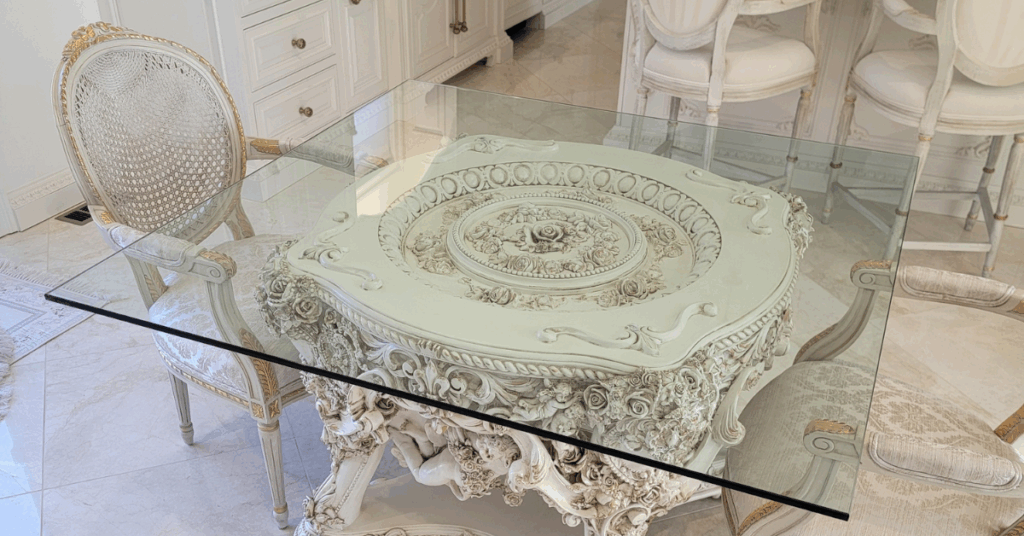Over the last several years, there’s been an emerging preference among homeowners for clean, sleek, minimalist aesthetics in their homes. That preference isn’t just limited to architecture, either. It encompasses everything from doorframes and walls to furniture and appliances. With these minimalist looks comes the need for something clean and simple, yet durable and suited to the homeowners’ preferences. For tables, one great way to achieve this is through glass table tops—more specifically custom glass table tops.
In this blog, we’ll go over all your options, as well as what you should take into account when ordering your custom glass table tops.
Choose the Right Glass Type
The spectrum of quality when it comes to glass is pretty wide, so you want to make sure you end up with something that’s durable. There are two main types of glass:
- Annealed Glass: This is the standard, untreated variety. It’s more affordable, but it’s almost more prone to breaking. When it shatters, the pieces are often sharp and dangerous.
- Tempered Glass: This is treated to be safe and strong. If something does manage to shatter it, it breaks into small, blunt pieces that minimize sharp edges, thus offering more safety.
Tempered glass is usually the better choice. You’ll thank yourself for investing a bit more money upfront, as it will likely save you more in the long run.
Pick the Proper Thickness
Glass table tops can be manufactured in various thicknesses, the most common being the following:
- 1/4 inch: These are generally used as protective overlays for non-glass tops.
- 3/8 inch: A popular choice due to its versatility.
- 1/2 inch: Great for standalone tops and heavy-use tables that cover a large area.
When you’re trying to decide on thickness, ask yourself how large the table is and how it will be used. A dining room table, for example, will likely need to support a decent amount of weight, so you should consider 1/2 inch glass.
Decide on Edge Style
The edge of your custom glass table top should prioritize safety, but there is the aesthetic angle to consider, as well. Flat polished edges are clean, modern, and smooth. Beveled edges offer a more decorative, elegant look. Pencil edges are rounded with a soft curve to enhance safety. Then there’s what’s called the Ogee edge, which is highly ornate and layered.
Your choice here should mesh with the style of other things in your room without compromising on safety—more so if the tables are low or placed in high-traffic areas. Nobody wants to scratch themselves on an innocent-looking piece of furniture.
Select the Shape and Dimensions
This is where the “custom” part of glass table tops comes in. Make sure you take accurate measurements of the space in which you want your table to live. Note length and width or, if you’re ordering a round-glass table top, the diameter. If your goal is an irregular shape (like a bean), templates and tracings are the better option.
We’re always happy to do standard shapes like rectangles, squares, ovals, and racetrack, but we also love a good challenge. If you have an idea for a truly unique table, we’re ready to step up!
Consider Function and Placement
Where will your table be? How will you use it? These considerations can play a big role in your decision. Let’s take a look at a few scenarios:
- Indoor vs. Outdoor: Outdoor tables will require thicker, tempered glass so they can withstand the elements. Indoor tables won’t be subjected to these natural strains, so they can generally be thinner (we still recommend tempered glass, though).
- Base Compatibility: Make sure the base of your table will be able to provide even support. If the base is unstable, the glass can be too stressed, which could lead to cracking and even breaking.
- Overlay vs. Replacement: Do you want a full glass top or a protective layer over an existing table top?
Safety and Installation Tips
Being such a heavy material, even tempered glass requires proper handling. We’re always happy to handle glass table tops until they’re secured in their rightful place, but here are some safety tips in case you’re a DIYer.
- Weight Considerations: Thicker glass weighs more. Make sure the base of your table can handle it!
- Non-Slip Pads and Spacers: These help prevent glass table tops from shifting, at the same time providing a soft barrier between the glass and table base.
- Professional Installation: A small rectangular or round glass table top is manageable for many people, but larger, more complex shapes really should be left to the professionals. It maximises safety and proper installation.
Trust the Experts in Glass Table Tops
At The Glass Guys, we know custom glass. If you’re considering a custom order for glass table tops, we’ll make sure everything is cut to the proper size, handled with care, and installed correctly. Get in touch with us and we’ll create a glass table that fits your style to a T!


